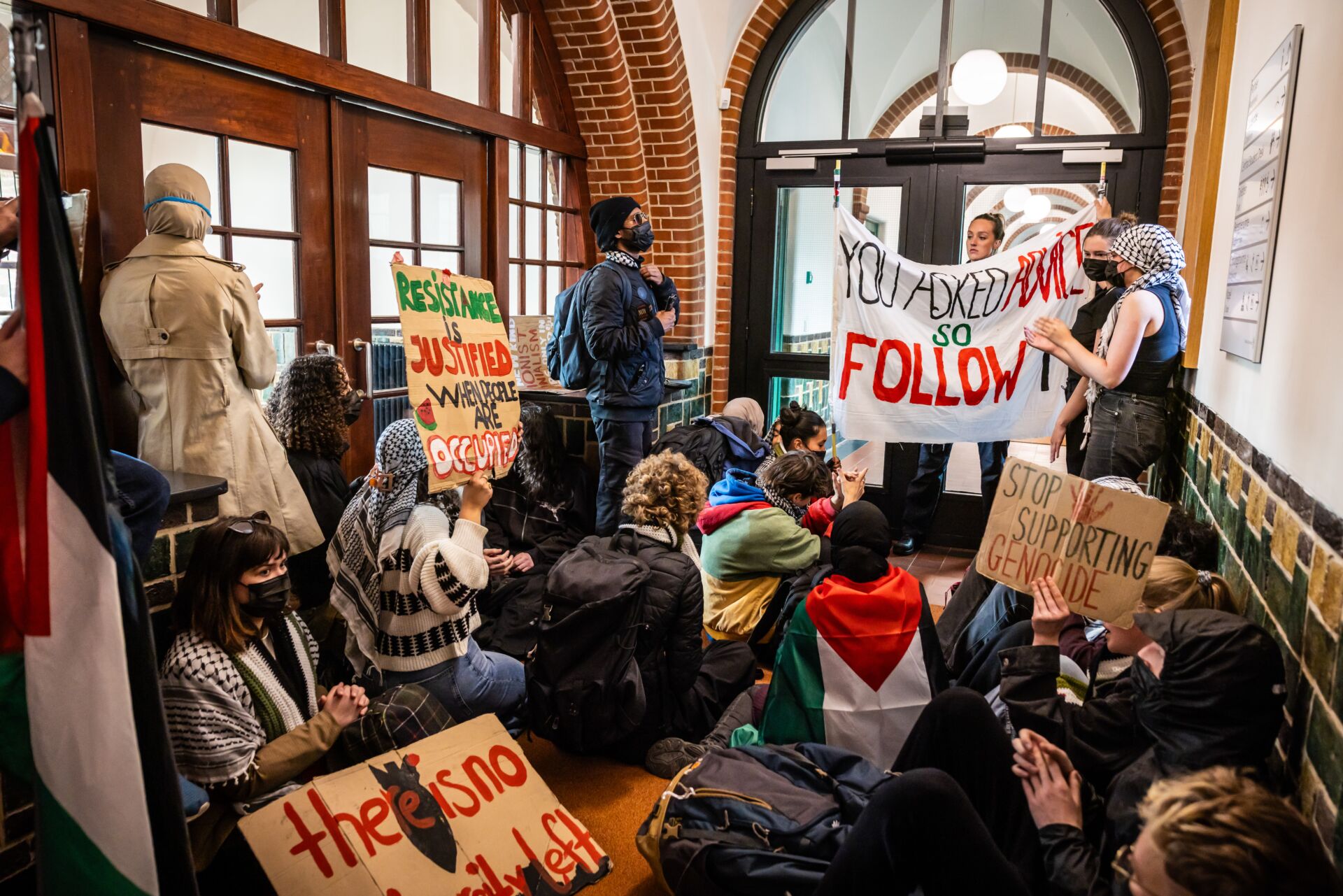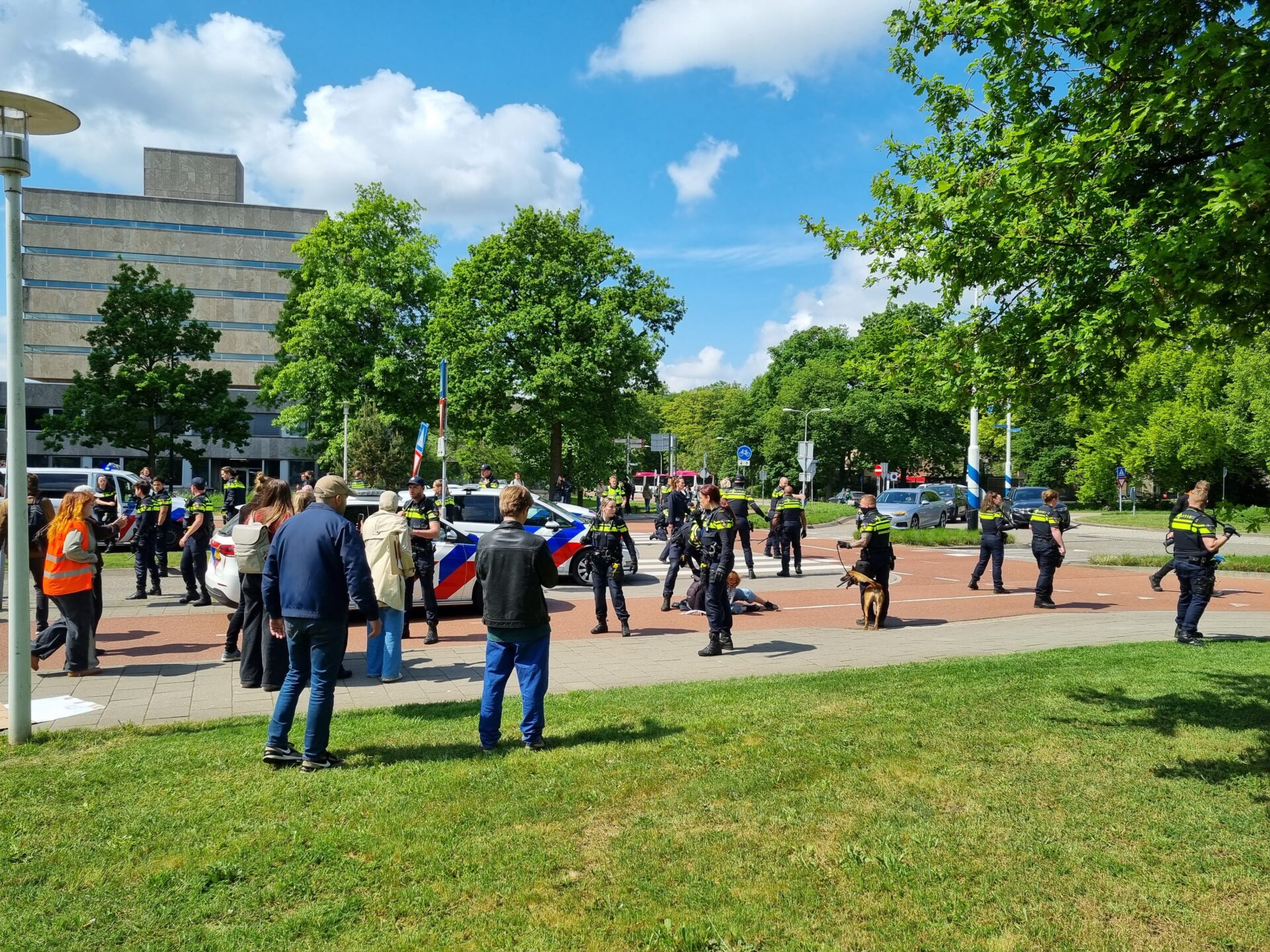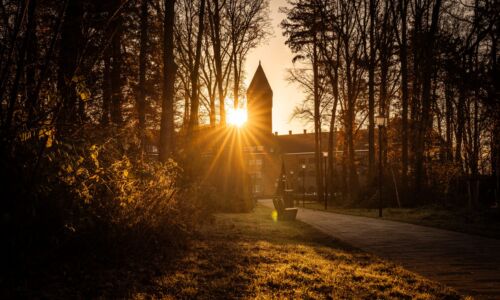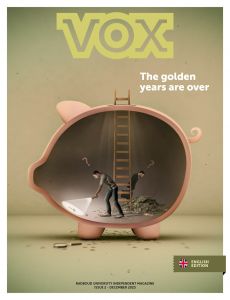Report fails to dispel uncertainty over major police operation and dog bite on 7th of May
-
 De politie verrichtte aanhoudingen na afloop van de demonstratie. Foto: Marcel Krijgsman
De politie verrichtte aanhoudingen na afloop van de demonstratie. Foto: Marcel Krijgsman
The police scaled up their response considerably during the demonstration of 7 May, in which a student ended up being bitten in the leg by a police dog. The police were responding to a report from the University about a ‘large group of protesters’ using violence to enter the Berchmanianum. So says the report of an investigation about the events of that day by Berenschot. However, what exactly happened in the Administration Building remains unclear.
The report about the 7 May demonstration, which culminated in a major police crackdown, is ready. The report, which was just published on the University website, describes the events leading up to and following the three arrests on Heyendaalseweg, in which a student was also bitten in the leg.
The report states that the police were called after protesters used violence when entering the Berchmanianum. According to the document, one security guard was elbowed against the neck by a protester, a second was bitten on the hand when he tried to take a protester’s face mask. Both guards filed charges. A third university employee was scratched by a protester, the report says.
Indignation
Following these events, a security guard called the police, telling them that ‘a large group of protesters had entered the Berchmanianum and violence had been used’, after which the police decided to scale up substantially. An officer who entered the Berchmanianum to speak with the Executive Board was told that this was not possible due to an important Teams meeting taking place at the time. The activists who, according to the report, used violence were identified outside the Berchmanianum a short time later, and were later detained on Heyendaalseweg.
The reason for the investigation was the fact that the arrests had gotten out of control , including a student being bitten in his leg by a police dog. The student had to undergo a total of five operations and suffered permanent injuries from the bite. The police action led to great outrage on campus. The Executive Board said it deplored the violence, but refused to apologise. A large group of staff members joined student union AKKU in calling for the Executive Board to resign. The Ombuds Officer wanted an independent investigation into the events, for which they commissioned Berenschot (see box).
However, it is still unclear what exactly happened in the Administration Building. ‘There were several moments when physical contact occured between protesters and security. There are different perspectives on the behaviour of both the group of protesters and the security guards inside the Berchmanianum, so no clear picture of the situation can be given,’ the document states.
Security guards
The report states that the protesters headed towards the Berchmanianum, where President of the Executive Board Alexandra van Huffelen walked out to talk to the group. She did so without checking with security, which would have been the usual protocol according to internal documents. One security guard walked out with her. When the protesters’ spokesperson covered her face with a keffiyeh, Van Huffelen indicated that she would not engage in conversation with anyone wearing a face covering, following which she walked back inside. Some protesters followed her into the Berchmanianum.
The security guard tried to stop the protesters, but was unable to do so due to their number (15 to 20 people), according to the report. A little later, in the hall of the building, some security guards tried to get the group to go back outside – but without success. The group of activists moved further into the building, leading to pushing and pulling.

According to some of the reporters, the security guards started pushing and pulling without cause. These reports also spoke of a loud but peaceful demonstration. Other people the investigators spoke to contradict that view. According to them, a protester bit a security guard’s hand when the security guard tried to remove the face mask covering their face. According to these reporters, a university employee was also elbowed in the throat, and another employee was scratched.
Two different versions were juxtaposed because the situation was really chaotic, Ombuds Officers and commissioning officers Job van Luyken and Aukje Verstegen explain. ‘People were standing close together, emotions were running high, and everyone saw or felt something else happening,’ says Van Luyken. ‘At such times, it makes sense that people’s stories differ.’
‘As an investigator, you have to be very careful in such cases,’ Verstegen adds. ‘You cannot pretend that there is only one truth when things are perceived differently. Berenschot has chosen to showcase the two versions side by side – which we think is fair and thorough. It shows how different people can experience the same event. It also forces us in future conversations to not pretend that there is only one story.’
Police deployment also included
After several minutes, a security guard contacted the police and told them that ‘a large group of protesters had entered the Berchmanianum and violence had been used’. Based on this, the police control room called in a large number of police units. Fifteen minutes later, police arrived with ‘10 to 15 cars and buses.’
The police action was not originally supposed to be included in the investigation report, but the investigators ended up speaking to the police anyway. ‘The reason is that many of the reports were about the arrests, the tensions at the roundabout, and of course the dog bite,’ Van Luyken says. ‘You can’t just ignore it then.’
Investigation by Berenschot
The Ombuds Officers acted as commissioning officers for the investigation conducted by Berenschot.
The Berenschot investigators studied documents such as university protocols around demonstrations, job descriptions and communication from the University around the demonstration. A total of 32 people reported to Berenschot’s hotline. The investigators conducted interviews with several reporters, the President of the Executive Board, a university spokesperson, security guards, and a police officer. The researchers also studied media and social media messages and examined visual material.
Berenschot’s brief was only to present the factual events that arose on campus on 7 May, the investigators write in the report. But as many reports and interviews also highlighted the impact of events and associated emotions, these were also included ‘where relevant’.
The report describes how a police officer entered the building and found two emotional security guards. The officer also wished to speak to the Executive Board about their position, but ‘was told by spokespersons of the Board that due to an important Team meeting at that particular time, the Board could not be disturbed.’
The police officer then spoke to the protesters, asking them to vacate the building within five minutes, which the activists did shortly afterwards.
After leaving the building, the group was briefly stopped by police. A university employee shared with the police, from their own observation, which protesters had elbowed a security guard in the throat and bitten another guard’s hand. At this point, the police decided to arrest these two persons. The police meanwhile scaled down their operation, leaving about 20 policemen involved in the deployment.
Police dog
A police dog handler was also present during these events. According to the report, police dogs tend to be deployed in incidents involving a larger group of people because of the deterrent effect. In the meantime, the police were discussing among themselves how to make the arrests in a peaceful manner.
A group of about 10 people walked towards the Erasmuslaan-Heyendaalsweg roundabout, where 15-20 police officers were also present, who proceeded with the arrests. For the protesters, the report says, it was unclear at the time why the arrests were taking place.
‘Statements and visual material show police standing with truncheons in hand and police officers hitting protesters who are getting close.’ According to the report, the police did this because the arrests involved resistance from protesters and because the activists did not keep enough distance from those being arrested.

The report is less clear regarding the infamous incident in which a student was bitten in the leg by a police dog. The exact moment of the bite cannot be seen on photographs or camera footage and it is unclear why the dog bit, according to the investigators. According to a bystander, the biting incident took place unexpectedly. The student in question told Vox the same thing, saying that the dog had suddenly come from behind. The report also states that someone told the investigators that the student reached over the dog, thereby getting too close, after which the bite occurred.
In response to the deployment of police with truncheons, protesters shouted and screamed, which led to other protesters appearing on the scene. Police officers pushed protesters to the ground and struggled with them. Several reporters the investigators spoke with indicated that one of the protesters sustained a damaged kneecap. Visual material that investigators were able to see showed police stating several times that activists should keep their distance or violence would be used. Three protesters were then arrested. Eventually, the police left.
Medical bills
The report mentions that the University provided aftercare: both for students who had witnessed the police dog incident and for the security guards who were present at the incidents.
Aftercare for the student who was bitten by the police dog was provided through the Faculty. The student’s parents were invited to come over and their medical bills were paid, both at the University’s expense. Conversations were held with the student about their future and how the University could contribute to it. In an earlier interview with Vox, the student stated that from Executive Board had offered neither apology nor help.
‘It seems contradictory, but both are true,’ Van Luyken says. ‘Aftercare was organised through the Faculty. So care was definitely provided, but not by the Executive Board itself. So it is quite understandable that the student’s experience was different from what was formally arranged. That difference between formal care and experienced care is really something to take seriously.’
Demonstration right
The question of whether a second 7 May can be prevented in future is beyond the scope of the investigation, but Verstegen would like to comment on it. ‘The question is whether you can prevent it. This requires something from all involved. The right to demonstrate is a very good thing, as is respectful interaction.’
‘Our work is certainly not finished now that this report is completed. This is actually the starting point. The facts are there, now we need to talk to each other. It is up to the Executive Board, faculties, participational bodies, and the entire university community to use this as a basis for a good and thorough follow-up. As Ombuds Officers, we remain available to support those involved and oversee further handling with transparency and integrity,’ she concludes.



